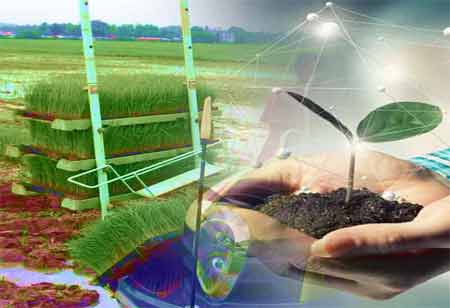Thank you for Subscribing to Agri Business Review Weekly Brief
Futuristic Extension Techniques for Smart Agriculture
The advancements in livestock farming are critical amid population growth and environmental concerns.

By
Agri Business Review | Thursday, March 21, 2024
Stay ahead of the industry with exclusive feature stories on the top companies, expert insights and the latest news delivered straight to your inbox. Subscribe today.
QR code technology linked to blockchain verifies animal product authenticity, addresses consumer concerns, fosters trust, and streamlines compliance, supply chain transparency, and ethical practices.
FREMONT, CA: The advancements in livestock farming are critical amid population growth and environmental concerns. Innovative livestock extension initiatives spearhead an agricultural revolution, employing advanced technologies and creative strategies to enhance productivity, sustainability, and animal welfare. These forward-looking approaches aim to transform animal production methods to meet increasing demands while minimizing environmental impact and adhering to ethical standards. Exploring diverse cutting-edge approaches across technology, biology, and societal realms is crucial for extending capabilities into the future.
Artificial intelligence encompasses creating computer systems capable of executing tasks conventionally requiring human intelligence, such as learning, reasoning, and problem-solving. These systems, designed to imitate human cognitive functions, are categorized into narrow or weak AI, specialized for specific tasks like virtual personal assistants or image recognition, and general or strong AI, which aims to replicate human-like intelligence across various domains. This poses a persistent challenge in AI development.
AI is divided into machine learning, where systems learn from data and improve over time, and deep learning, a subset involving neural networks with multiple interconnected layers. Augmented intelligence differs from AI because it focuses on enhancing human capabilities through collaborative interaction with AI systems rather than replacing human intelligence. These systems are designed to complement and improve human skills, aiming for a symbiotic relationship between humans and AI to assist decision-making.
Tools like augmented intelligence provide insights, predictions, and data analysis to enhance decision-making. They leverage human interactions and feedback to gradually improve performance. This iterative learning process involves refining algorithms and adapting to evolving situations while prioritizing ethical considerations, transparency, and accountability to address concerns about bias, fairness, and responsible AI use.
Fundamentally, artificial intelligence strives to develop independent task-performing machines, whereas augmented intelligence aims to bolster human intellect and decision-making by capitalizing on human and machine capabilities. Integrating human intuition, creativity, and critical thinking with AI’s analytical prowess generates a synergy, offering potent and efficient solutions across diverse sectors like healthcare and business.
Role of Artificial Intelligence in Smart Livestock Farming
The integration of Artificial Intelligence (AI) plays a crucial role in transforming traditional livestock farming into more innovative and more efficient practices. By incorporating AI technologies into intelligent livestock farming, there is the prospect of enhanced productivity, optimized resource allocation, and improved animal welfare standards. Here are key areas where AI is making an impact.
Precision Livestock Farming (PLF) and behavioral analysis:
In health monitoring, AI-powered systems oversee the well-being of individual animals through the analysis of sensor data, including information from wearables or cameras. Early detection of any indications of distress or illness is possible, facilitating timely intervention. AI algorithms scrutinize the behavior of livestock to pinpoint patterns suggestive of stress, disease, or related concerns, with alterations in behavior prompting alerts for further examination.
Predictive Analytics: In livestock management, AI predicts disease outbreaks by analyzing past data, environmental conditions, and animal health records. This proactive approach allows for preventive actions to mitigate disease spread. Additionally, AI algorithms assess reproductive cycle data, empowering farmers to forecast prime breeding periods and enhance breeding effectiveness.
Automated Monitoring and Management: AI-managed feeding systems enhance feed distribution by tailoring it to each animal's nutritional requirements, thereby boosting efficiency and minimizing waste. Additionally, AI regulates and enhances environmental factors such as temperature, humidity, and ventilation in livestock facilities, ensuring ideal animal living conditions.
Data-Driven Decision Making: By incorporating data from diverse sources like sensors, satellite imagery, and weather predictions, AI offers farmers actionable guidance to enhance decision-making processes. This encompasses refining feed compositions, resource management, and adjusting to environmental shifts. Moreover, AI streamlines the livestock supply chain by improving logistics, anticipating market needs, and ensuring punctual product distribution.
Facial Recognition and Biometrics: AI-driven facial recognition and biometric systems offer a valuable tool for identifying individual animals, aiding in the monitoring and supervising of livestock across their lifespan.
Robotic Applications: AI-driven robotic systems for milking and shearing tasks offer farmers increased efficiency and decreased physical strain. Additionally, AI-powered autonomous vehicles handle duties like feeding, cleaning, and livestock monitoring, reducing labor expenses and enhancing farm management.
Economic and Environmental Sustainability: In agriculture, AI aids farmers in maximizing resource efficiency, encompassing water, feed, and energy, thus fostering economic sustainability. Through facilitating precise management techniques, AI plays a role in mitigating the environmental footprint of livestock farming, which includes reducing nutrient runoff and emissions.
This technology facilitates consumers in confirming the authenticity of animal products by scanning a QR code on the packaging, granting access to a secure, unalterable record of the product's journey. Growing concerns regarding ethical sourcing and animal welfare are driving consumer interest. Furthermore, it enables producers to showcase and validate ethical practices, fostering consumer trust. Blockchain streamlines the recording and verifying compliance with regulatory standards and certifications, alleviating administrative burdens on farmers and ensuring precise, auditable records. With blockchain integrated with IoT, animal production and health management can be more transparent, efficient, and reliable, addressing problems like disease control, transparency in supply chains, and consumer expectations for ethical and sustainable practices.





